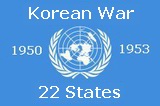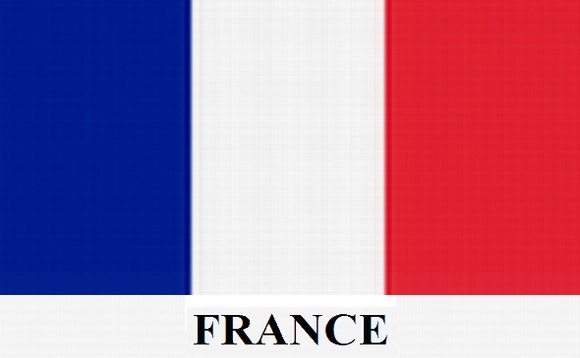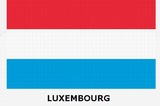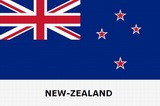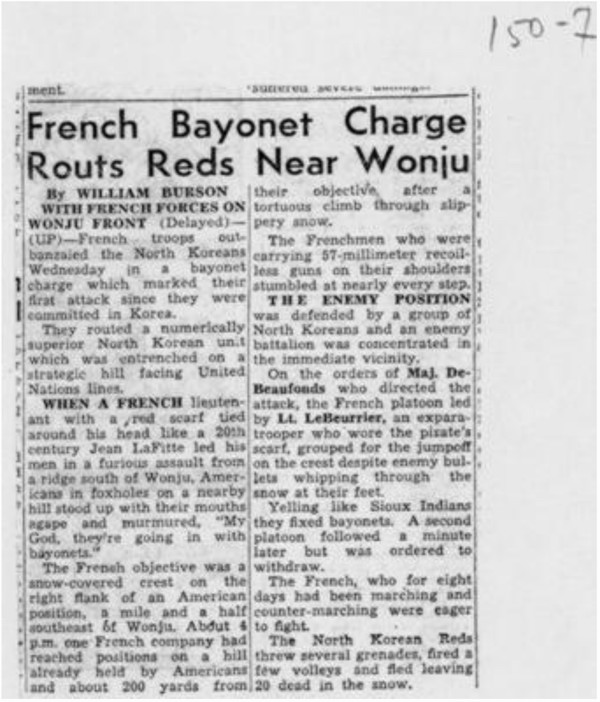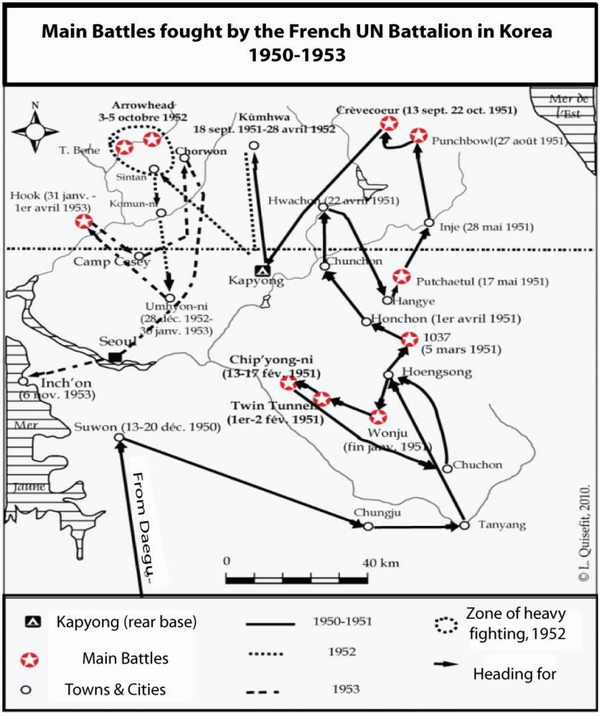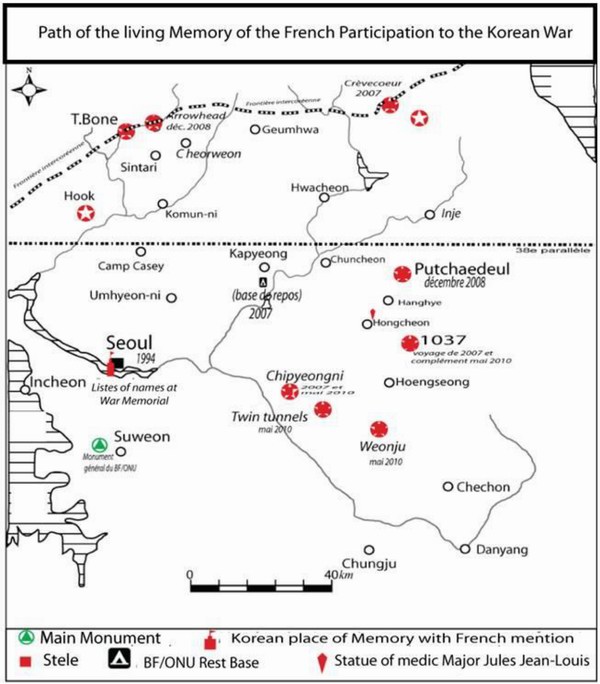The French Participation in the Korean War and the Establishment of a “Path of Memory” in South Korea
By Laurent Quisefit
Center for Korean Studies, EHESS (School for Advanced Studies in the Social Sciences), 22 avenue du Président Wilson, 75016, Paris, France
Abstract:
The contribution to the Korean War of medium powers or declining great powers like France has been scarcely investigated in-depth despite France’s marked contribution to the conflict, both diplomatically and militarily. Though its contribution modest by way of the number of troops sent to Korea and discreet on the diplomatic field, the French part in the war was significant, because it demonstrated the solidarity of the Allied powers united in the newly-established NATO. Moreover, the French battalions sent to Korea fought with gallantry and gained many medals, including silver stars. From the beginning of the 2000s, this overlooked history began to be noticed with the building of a “Path of the Living Memory of the French Contribution to the Korean War”. It was intended to inform visitors about a part of history, to transmit memory, and to strengthen friendship between France and Korea.
- Introduction
Due to the relative modesty of their involvement [1], as well as the desire to keep secret certain military archives from this period, and more prosaically the inability to master the needed languages [2], the role of medium and regional powers [3] in the Korean War has rarely been investigated [4].
The dearth of historical works regarding France’s participation in the Korean War [5] also fit with the above mentioned reasons. Studies written since the end of the war have analyzed the wider international effects of the Korean conflict or the legal aspects of the war. A handful of testimonies, written by veterans, during [6] and just after the war [7], appeared in books of uneven quality. From the 1980s on, an occasional scholarly analysis could be found while a handful of doctoral dissertations were devoted to various aspects of the Korean War. Unfortunately, some of them contained many errors.
From 1953–2006, out of the 13 PhD dissertations defended in France [8], 10 were presented by Korean students and only one, in 2006, directly dealt with France’s role in the Korean War [9], as the Koreans seemingly preferred to do research about their own country [10]. It is also true that the relevant documents in the French military and diplomatic archives were inaccessible for many years due to the restrictive French National Archives regulations of 50 years, and were not fully available until the 1990s, though it still was possible to interview veterans.
During the Korean conflict, France tried to stop all initiatives which could lead to an escalation of tension, especially regarding China, bearing in mind the fears of a Chinese attack against French Indochina, where the Indochinese War had been raging since 1946. In the meantime, France was manifesting a deep solidarity with its old American ally, through full support in official conferences and a limited military involvement on the Korean battleground.
The aim of this paper is to explain how and why France participated in the Korean War, and especially how after the war, some Korean and French veteran associations, and local and national authorities decided to commemorate the French participation in the conflict and French sojourn in Korea through the building of a “Path of the Living Memory of the French Contribution to the Korean War”.
- France and the Korean War
Due to political instability in Paris [11], the French Cabinet resigned on July 24, 1950, which meant that France was bereft of a government at the outbreak of the Korean War. The news of the war in Korea reached Paris while French President Vincent Auriol was trying to find a prime minister able to form a new cabinet. Indeed, on a Sunday morning, Auriol [12] met several politicians in order to choose the new head of government. During this period, the French president had little political influence, as the real power lay in the hands of the président du Conseil, that is to say, the prime minister. In the afternoon, however, Auriol summoned Alexandre Parodi, the then French foreign office’s general secretary, to talk about the Korean crisis. The president’s concern about the Korean affair was great and the situation raised three worrying questions:
(1)Was the fighting in Korea a truly independent conflict or was it a kind of deception, aiming at luring US Forces far from Europe and bogging them down in Korea?
(2)Was Europe the next place of a “hot” war between East and West?
(3)Did the North Koreans really invade the South, or did Americans attack first [13], as Communist propaganda claimed?
Finally, on June 30, 1950, Henri Queuille [14], a moderate socialist political leader, was appointed président du Conseil. Immediately after assuming his duties, he addressed parliament. While he failed to even mention Indochina, he did state that “for the first time, the principle of collective security principle, established by the birth of the United Nations (UN), could be applied to Korea” ([15], p. 279).
However, on July 4, having just formed his cabinet, Queuille suffered a vote of no confidence in parliament, with 334 votes against him and only 221 in his favor. As a result, France was once again in a need of a government.
Eventually, on July 12, René Pleven [16] was appointed prime minister. In his first address to parliament, he referred to the situation in Korea, not in order to send troops there, but to issue a call for national unity with government stability; he underlined the necessity to unite and to display sangfroid, good temperament, discipline, “concern for the fatherland”. This objective, however, did not mean a withdrawal of France from international engagements. The prime minister explained, on the contrary, that it meant that France would be loyal to the UN [15], advocating mediation between the two Koreas, and thereby supported the British and Indian initiatives in favor of negotiations (especially the Indian attempts of conciliation in October 1950, the British Buffer Zone proposal in November 1950 or the Indian proposal for a Three Persons Committee to seek a ceasefire in December, and a number of other initiatives [17].
Despite these efforts, news from Korea was very bad during this summer in 1950. Many French intellectuals and politicians noted that some people, fearing a new war just five years after the end of the Second World War, had bought canned food, sugar, soap, and other basic necessities. Raymond Aron, the famous French specialist of international relations and philosopher, referred to this as a quasi-panic [18] which, fortunately, did not last long.
In 1950, France was already at war on the Asian continent, where the French Army was suffering heavy losses at the hands of Ho Chi-Minh’s Vietminh [19]. In this period, the Indochina War attracted little public support in France, as some of the wounds of the Second World War had yet to heal. Moreover, the Indochina War was too expensive for a weakened nation as France was after the Second World War. Moreover, Indochina was geographically far from France, and the French colonial and administrative community living there was not that significant, perhaps 30,000 people altogether. Conversely, the French military commitment was heavy. The French so-called Corps Expéditionnaire d’Extrême-Orient (Far East Expeditionary Corps) reached between 94,000 and 150,000 men, and France alone could not afford the financial burden of this war [20]. France’s political agenda was dominated by European concerns, especially French domestic issues (employment, reconstruction, education), and questions of building anew a French military force in order to deter a possible Soviet attack. These were the main concerns of the socialist cabinet. The French government consequently focused its efforts on French and European matters.
Though unable to react immediately to the Korean affair, French diplomacy immediately took measures and voted with France’s allies on the UN Security Council.
After the North Korean attack of June 25, 1950, France, as a permanent member of the UN Security Council, not only voted for Security Council resolution 82 determining that the North Korean attack was a “breach of the peace” but called upon “the authorities in North Korea to withdraw its armed forces” (June 25, hour of New York) [21], and also, approved the Security Council resolution 83 (of June 27), recommending that the UNO members “furnish such assistance… as may be necessary to repel the armed attack”. On July 7, the French delegate to the UN, along with the British delegate, also presented a resolution giving the command of the UN forces to the United States of America. Consequently, General Douglas MacArthur, then head of the Supreme Command of Allied Powers (SCAP) in Japan, was put in charge of the United Nations Command in Korea.
Though under a Socialist government that was led by President Vincent Auriol since 1947, France participated in the Korean conflict by sending a naval unit (FS La Grandière) operating in Indochina [22] as early as July 1950. However, as noted above, French forces were already fighting in Asia, and the French government did not want to divert more of its resources from Indochina or from Europe.
French authorities were very embarrassed when the war broke out in Korea due to the internal pressure of the French Communist Party, one of the most powerful political factions in France at the time [23,24]. The Indochina War, which lasted eight years, was unpopular in France, and the French government did not want to spend more money for Korea and, thereby, enable the communist forces to exploit this discontent.
In August, however, France decided to answer UN and American solicitations. The question of France’s involvement in the Korean War was debated at the August 18, 1950 session of the National Defense Committee. President Auriol then said that the French effort in Indochina could allow limiting France’s participation in the Korean War, that is to say a purely symbolic action. “This action had to be done and instructions sent to the French ambassador in Washington, to explain our position to the Americans, and to insist on the importance and meaning of our action in Indochina”. Prime Minister Pleven shared this position. He explained that France’s participation in the conflict could lead to good things. “Moreover, it fits the principles of collective security we defended so many times in the International Assemblies”[25].
Although in agreement, Minister of Defense, Jules Moch, stated that even “dispatching a volunteer battalion is technically impossible”. Besides, he was doubtful regarding “the political opportunity of such a decision” [25], because of the political situation in France, where communists were an important political force, and where the communist propaganda was promoting the thesis of South Korean aggression. Also, perhaps due to the communist disinformation campaigns, Moch was skeptical about the North Korean responsibility in the Korea War, and thought that the South also shared responsibility for the conflict. He therefore opposed the dispatch of more than one battalion to Korea [26].
Jean Letourneau, the Minister of the Relations with the Associated States [27], contended that it was necessary to send a battalion in Korea. “By doing so, we will be logical with ourselves and we shall consolidate our situation in Indochina at an international level. Our participation in the Korean War, though modest, shall guarantee us the Allies’ assistance in case of new difficulties in Indochina” ([25], p. 17).
The French decision to participate in the Korean conflict was indeed closely tied to the situation in Indochina, and President Harry Truman’s speech of June 27, 1950 was highly praised in Paris, especially regarding the increase in the US assistance given to Indochina.
Finally, Pleven explained that “to involve ourselves, even in a symbolic way, presents many disadvantages. To do nothing is worse” ([25], p. 17). Five days later, an official press release announced the creation of an all-volunteers battalion, especially created to participate in the Korean War under the UN flag.
- The French Army in the Korean Conflict
The official announcement of the creation of a brand new unit intended to be sent to Korea under the name of “Bataillon Français de l’ONU” or “BF/ONU” soon nicknamed the “Boeuf/ONU” (Beef UNO), was made by press release and internal mail dispatched to all barracks, in France or in the French Associated States, and reached even French occupation forces in Germany.
The volunteers soon joined the Auvours Camps (near Le Mans), where the men were physically and psychologically evaluated. Some of them were “civilians”, coming from the “reserve” (Home Guard), but this term is in this case an understatement, for most of these men had already seen war. Most were in Libya, in Tunisia, in Italy; they had fought in France with the army or in the resistance, then in Germany in the last months of 1945. Some of the men in active service even fought desperate fights against Japan in Indochina. Some of the younger ones already had been touring Indochina after the Second World War. Therefore, though a call for both “reservists” and men in active service was made, all the volunteers were, in fact, cold-blooded professionals who knew very well what war could be. Usually in their twenties, they were just a little bit older than the men in the US Army. They were experienced men who knew the meaning of duty, and shared the same political thoughts and aims: anticommunism, solidarity with the American and British allies, assistance to a weak Korean Republic assaulted by the Soviets, or for some officers, the exciting perspective to be the first peace soldiers under the UNO’s flag [27].
As Kenneth Hamburger points out, the decision to send a French battalion to Korea represented a risk for the French government because if there were a failure in combat operations, all efforts to obtain the US military assistance in Europe and in Indochina would be in vain ([1], p. 65). Therefore, the BF/ONU was a fake one, a kind of fiction, which was made up of experienced volunteers and did not reflect exactly the situation of regular units, as the French Army was mainly a conscript army, though with a core of experienced active service men. Consequently, the BF/ONU did not reflect at all the situation of an average French Army battalion made up of a core of active servicemen and sometimes reluctant conscripts [28].
Leaving Marseilles on October, the BF/ ONU disembarked at Pusan on November 29, just as the Chinese offensive began to sweep General Macarthur’s forces. Involved in battle operations at the end of December, after a short drill, the French battalion was integrated to the 2nd US Infantry Division “second to none” [29] and assigned to the 23rd US Infantry Regiment. The 23rd Regiment’s Commander Colonel Paul L. Freeman Jr. accepted including the French battalion in his unit, though the French were commanded by General Ralph Monclar [30], an old foreign legion officer, who had displayed the utmost gallantry in Verdun in 1916, in Narvik in 1940, and in Ethiopia in 1941. General Monclar even had abandoned his stars to become a fictive lieutenant-colonel, in order to command the French battalion, for no general can be in command of such a small unit as a battalion, and was eager to serve in the first UNO’s Army, though he was already 60 years old.
The French battalion participated in all the decisive battles of 1951, especially Wŏnju, Twin tunnels, Chip’yŏng-ni [31], 1037, and Crèvecœur (Heartbreak Ridge).
The French displayed not only gallantry and stubbornness but also a challenging spirit. They had volunteered to fight, and they did. They displayed initiative and willingness to sacrifice, along with great pragmatism, though sometimes lacking discipline, at least according to US Army standards.
One anecdote is significant. During the bitter cold of the Korean winter, the French made fires to warm themselves and to soften the frozen ground in order to dig it. These lights alarmed the 23rd Regiment officers, anxious about possible enemy attacks. When Colonel Freeman told Monclar to put these fires out, the French general replied that if the Communists knew where the French were, they would attack the French battalion, and then the French could kill them… [32].
In Wŏnju, during the first battles of 1951, two platoons of the BF/ONU launched bayonet charges against the enemy, in their own sector. Though the French were firing and hurling grenades, the rush of shouting men, with bayonets fixed, through unprepared Korean and Chinese units scared the Communist troops. Lieutenant Lebeurrier’s platoon ran through a whole North Korean company and routed it. “This spirit of the bayonet” was what General Matthew Ridgway wanted in the entire Eighth Army, and he used it to inspire US Soldiers, telling them to follow the example of the French ([1], p. 94). In fact, the Turkish Brigade and the Belgian battalion sometimes conducted bayonet charges during the Korean War. The BF/ONU’s action at Wŏnju, however, came at a timely moment, just when Ridgway wanted to improve the morale of the Eighth Army.
A few weeks later in Chip’yŏng-ni (February 13–15, 1951), the French battalion and the 23rd US Infantry Regiment fought a decisive battle against the Chinese army. For the first time, the Chinese volunteers encountered hardened troops, well entrenched and protected by the first barbed wire network installed around the UN army positions. Air supplies and tactical support, and short and long range artillery shelling helped to successfully resist the communist force: at least five Chinese Infantry Divisions attacked the Allied forces in Chip’yŏng-ni. As some UNO positions were being overwhelmed by the enemy on the afternoon of February 15, the pocket was eventually rescued by units of the 5th Cavalry Regiment (Task Force Crombez) under heavy fire and stubborn Chinese opposition. The Chinese finally retreated from their advanced position inside the perimeter under the pressure of napalm bombardment and counter-attacks. The arrival of Task Force Crombez ([1], p. 204–207) with about 20 tanks was determinant in the final victory.
After the fight, Lt. Colonel John H. Chiles [33], commanding the 23rd Regiment gave an interview to American journalists about the recent fighting and explained how he had fought against five Chinese divisions alongside the French during the three days' siege of Chip'yong-ni.
He said that the “French were beyond praise”, that they always hold on their positions, always captured their targets and never abandoned taken ground [34].
The success of the Chip’yŏng-ni battle was welcomed as a major victory for at least two reasons. First, it stopped the Chinese offensive and permitted the UN forces to soon after launch a counteroffensive to regain the ground lost in January. Second, it concealed the reversal which occurred in Hoesŏng, where the Dutch battalion attached to the 38th Infantry Regiment suffered heavy losses at the hands of a communist commando who killed most of the commanders of the Dutch unit, along with the dramatic losses of about 2000 men experienced by allied troops in the area [35].
The gallantry of the men of the 23rd Regiment, and their French brothers-in-arms was also a useful propaganda tool in order to boost a fighting spirit deeply damaged by the Chinese winter offensive.
Due to the rapid mutations of the Korean situation, and because of the war conditions, the French and the 23rd Infantry Regiment, having thus gained a reputation of bravery, were sent to most of the hot spots on the frontline.
Replaced at the end of 1951, then again in 1952 and at the beginning of 1953 by new men and officers, the BF/ONU gained the reputation of an elite fighting force which never abandoned its positions. In Wŏnju, the French even “out-banzaied the enemy” (sic) [36]. Laudatory articles were written about the “Frenchies”, such as “French Bayonet Charge Route Red near Wonju”, reported by the Pacific Stars and Stripes [37] (Figure 1 and Figure 2). Hard battles were also fought in 1952, at the T-Bone and near the Punch Bowl, at Arrow Head (Hwasalmŏri-koji), White Horse (Baengma-koji), Majuni, etc. (Figure 3).
At Arrowhead in October 1952, the engineer platoon, installed at the foot of hill 281, was almost completely annihilated by the red assault, in spite of a fierce struggle, just as the engineers of the first battalion had suffered dramatic losses in Chip’yŏng-ni.
The French battalion is one of the most decorated units of the Korean War. Indeed, the battalion by itself received not only French military citations and medals, but also two Korean Presidential Citations, two Distinguished Unit Citations, as well as other medals. [38]. Regulars, NCO’s and officers also got silver and bronze stars, French Croix de Guerre (The Cross of War), and other medals and distinctions.
During an address to the US Congress in May 1952, General Ridgway said of the French battalion: I shall speak briefly of the 23rd United States Infantry Regiment, Colonel Paul L. Freeman commanding, [and] with the French battalion… Isolated far in advance of the general battle line, completely surrounded in near-zero weather, they repelled repeated assaults by day and night by vastly superior numbers of Chinese. They were finally relieved….I want to say that these American fighting men, with their French comrades-in-arms, measured up in every way to the battle conduct of the finest troops America and France have produced throughout their national existence [39].
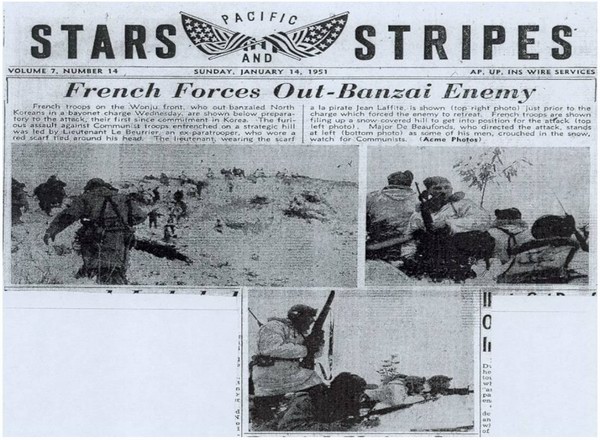
Figure 1. Front page of the Stars & Stripes Pacific Edition, January 1951.
Figure 2. Stars & Stripes Pacific Edition article, January 1951.
Figure 3. Map of the main battles of the French Battalion.
- Vanishing Memories of War
“Old soldiers never die, they fade away”. In 1993, the South Korean government decided to build a war memorial intended to transmit the history of the wars fought in Korea, in order to teach this history to the young generations, because the memory of the Korean War was vanishing with the men and women who had fought or were victims in the conflict.
In Korean minds, the Korean War holds the same traumatic place as the American Civil War for Americans and the two world wars for the Europeans. It was a national disaster which produced long-lasting trauma. Beyond the human and material losses, the 1953 armistice fossilized the division of the peninsula, and severed the relations of 10,000 families from their relatives in the North.
The Chŏnjaeng Kinyŏm-gwan (War Memorial) [40] in Seoul is not only a history museum, but also a sanctuary of national defense [41], and the names of the soldiers killed in action are written on the walls of the Memorial. The names of the men from 16 countries, who answered the United Nations’ call and were killed in action in Korea, are written on the walls of the galleries outside the Memorial.
Though Korean schools often arrange visits to the Memorial, the teachers barely explain which countries were involved and pay no particular attention to the small contributors. The Memorial is indeed very huge, and all the wars suffered by Korea, from antiquity to our days, are usually presented in a heroic and nationalist way.
The War Memorial was built to commemorate actors and victims in the wars which led to the modern Korean nation-state, focusing mainly on resistance against Japan and the Korean War itself. The purpose of the museum is also to educate future generations by collecting, preserving, and exhibiting various historical relics and records related to the many wars fought in the country, without saying, from a South Korean perspective, sometimes according to nationalist views, which often produce clichés. These stereotyped approaches are sometimes far from true history as seen in contemporary literary and historical materials, but they praise heroism and fighting spirit.
Other French “places of memory” [42] exist in Korea, and especially the French monument in Suwŏn, devoted to the memory of the 288 men killed in action, including the 18 missing in action, both Frenchmen and South Korean KATUSA [43] attached to the battalion. The memorial was constructed in October 1974 by the South Korean Ministry of Defense, “in tribute to and in memory of the French armies who came here as the crusaders of justice, to protect the security and freedom, made remarkable military gains, and died in the Korean War” [44]. Though the monument was restored in 2001 and developed as a memorial combining French and Korean cultures, it is deteriorating quickly, but had been renewed for the 60th anniversary of the Korean War. It is, however, used only once or twice a year for ceremonies.
In Tongchŏng-myŏn, in the province of Hongchŏn, stands the statue of the medic Major Jules Jean-Louis, who died out of mines while trying to assist two wounded Korean soldiers lying in the same minefield. This statue was built through the efforts of one of his former interpreter and medical assistant, Dr Kim Yang-Hŭi [45], and the support of various French and Korean associations. The statue was erected in 1986, during the commemoration of the centennial of the establishment of the relations between France and Korea. With General MacArthur’s statue in Inch’ŏn and the one of General Walton Walker (unveiled on June 2010), this is now only the third statue of a foreigner standing in Korea. Nonetheless, this statue stands in a remote place in the countryside, and very few people come to pay homage.
These monuments were not enough. The French battalion had fought or died in many places throughout South Korea (see maps). Since most of the Koreans, especially the young generation, know nothing about France’s participation in the conflict, and because the veterans, as well as the people who suffered from war, are vanishing—more than 60 years after the beginning of the Korean War—it was necessary to do something not only to preserve the memory of the participation of the French Army in the conflict, but also to build a new comradeship between the two countries.
Thus, came the idea of a “Path of the Living Memory of the French Participation in the Korean War” to be built in all places where the French battalion had fought. The project was promoted by the French Embassy and military attaché, which spared no efforts to persuade both Korean and French authorities to participate in the project. The French Korean War Veterans Association (ANAAFF/ONU), The Korean Ministry for Patriots and Veterans, the Korean Veterans Association, The French Ministry of Defense, and some private donators were also involved in the project.
A collection of steles and monuments, explaining briefly the conditions of the fight and the French Army’s participation in the war, under the motto “For Freedom” (Pour la liberté, Jayu-rŭl wihayŏ) (Figure 4), written in the three languages, with the UNO, French, South-Korean and US flags, the insignia of the French battalion and also the badge of the 2nd US Infantry division, was erected.
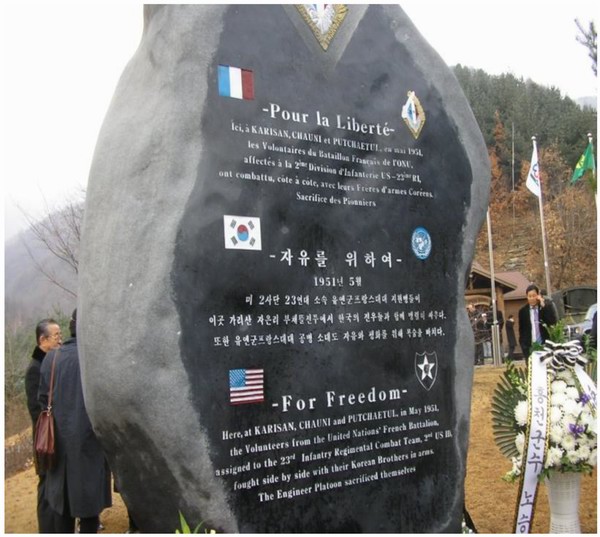
Figure 4. The Puchaetŭl Monument.
For instance, the monument at the entrance of the Puchaetŭl valley, near Inje, reads as follows: “Here, at Karisan, Chauni and Puchaetŭl, in May 1951, the volunteers from the United Nations’ French battalion assigned to the 23rd Infantry Regimental Combat Team, 2nd US ID, fought side by side with their Korean brothers in arms. The Engineer Platoon sacrificed themselves” (sic) [46].
In 2007, monuments were inaugurated in Pusan (UN Cemetery), Kapyŏng, Twin Tunnels, Chip’yŏng-ni, Hill 931-Heartbreak Ridge (Crèvecoeur). Afterwards, in December 2008, the monuments at Puchaetŭl and Arrowhead were unveiled. In 2009, only a small group of veterans travelled to Korea in order to prepare the ceremonies of the 60th anniversary of the beginning of the conflict.
In 2010, steles were erected at Wŏnju, Hill 1037, etc. (Figure 5). Some sites received new monuments in a second phase. In Puchaetŭl, where the French had positioned themselves on the hills, on a difficult ground, the monument has been installed in the valley. In the same way, the monument of Arrowhead was built on a hill facing the former positions, the sites being now inside the Demilitarized Zone (Figure 6).
Moreover, General Oh, the then commander of the South Korean 2nd Army Corps, had on his own initiative erected a commemorative monument in remembrance of the sojourn of the French battalion in Chunch’ŏn.
The aim to these steles and monuments is to allow ordinary people (except for the particular case of monuments still in military zones) to see, read and learn about French participation in the Korean War.
In Chip’yŏng-ni, the old school of this small town was used as a command post by the battalion Commander General Monclar. This school still stands in the city, and pupils visit the site every year. In other places, trekkers and walkers can see the commemorative monument while walking in the countryside or hiking in the hills.
School visits are encouraged. The pupils of the French high school in Seoul (Lycée Français) were associated to the ceremonies of the Arrow Heads monument inauguration in 2008.
Figure 5. Map of “The Path of Living Memory” stations.
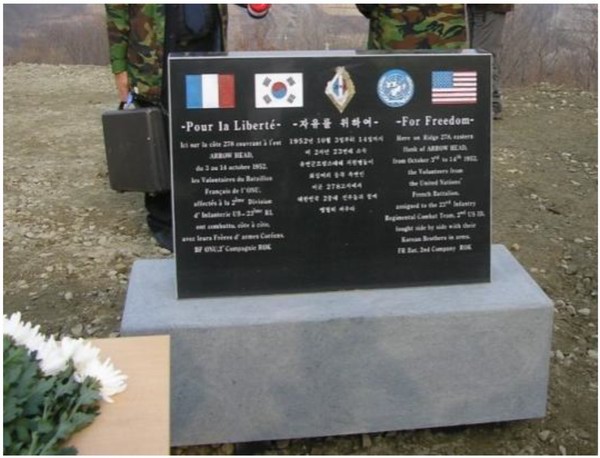
Figure 6. Arrowhead stele, facing the DMZ line
5. Conclusions
The mobilization of the past in bilateral relations can produce interesting results. Sometimes it can cause unintended consequences. For example, French participation in the Korean War was mentioned in the course of a speech inaugurating an exhibition presenting Korean cosmetics and accessories held in Paris a few years ago.
It is indeed interesting to note how, beyond the war, the mobilization of the past is significant in bilateral relations. Not only does it serve as a pretext for negotiation or dialogue between officials from both countries involved, thus presenting opportunities of political and economic exchanges, but sometimes also it bears fruits at the lowest, individual level.
Henry Rousso has written about the memory processes in action, from amnesia, to anamnesia and hypermnesia [47]. Sixty years after the outbreak of the conflict, people are eager to know, while others remain reluctant to talk, to tell how these dramatic and tremendous days were. Some are still wounded in their souls; others are only now remembering anecdotes and short stories. Many veterans do not like to talk with journalists, who they believe are unable to understand military life, war, entropy, fear and death. Some veterans think that transmission is possible only with other military people, and do not talk about the war, even with their relatives.
The commemorations of the 50th anniversary led to at least one international conference in Europe, but in France nothing was done during a long time, though French scholars participated in the Brussels Conference [48].
In November 2003, an official agreement between the Korean Ministry of Patriots and Veterans and the French Secrétariat d’État aux Anciens Combattants (Secretary of State for Veterans) concerning the shared memory of the conflicts of the 20th century.
In 2010, the Institute of Strategic Research of the École Militaire (IRSEM) in Paris organized a similar conference for the 60th anniversary of the war, in 2010 [49]. While the generation of the war is vanishing, the concern for the transmission of memory is growing.
Many war records, tangible and intangible, have already disappeared [41]. The generation of the men and women who fought the war, or were the victims of the conflict passing away. In 2011, four of the surviving KATUSAs of the French battalion were invited in Paris by the French Association of the Korean War Veterans to participate in the ceremonies at the Arc de Triomphe, where the Heartbreak Ridge battle’s anniversary is commemorated each October 12.
The French Army Historical Department (Service Historique de la Défense) also published a volume devoted to the history of the French UN battalion in 2010 [50], echoing the book written in Korea in 2004, through the Kukkabohunchŏ (Ministry of Patriots and Veterans), which was, unfortunately, hastily written and therefore somewhat inaccurate [51].
Moreover, no official organism or private foundation managed to record in a systematic way the testimonies of the survivors, in order to transmit not only war experiences, but also recollection of a passed world.
“The past is a foreign country: they do things differently there,” wrote L. P. Hartley. The veterans of the Korean War, were the men who travelled through this country, and they sometimes know better than Koreans today about what was Korea in the 1950s, before the Han River Miracle, computers and skyscrapers, cell phones and K-Pop, when the common landscape was the paddy fields, slow oxcarts on the roads, and almost all people wearing the traditional white costume.
Though it cannot transmit the experience of the French Veterans; the “Path of the living Memory of the French Participation to the Korean War” could make people think about these men from the other side of the Earth who came to Korea to protect a still weak country attacked by its northern neighbor. In July 2013; a new French veterans was made; probably for the last of the mass commemorations with veterans from all allied countries.
South Korea is extremely generous with the Korean War foreign veterans, and is helping them through various actions to participate in ceremonies, at home or in Korea. Sometimes, the commemorations include only a memorial service, with troops and military band, flowers and speeches [52]. In some cases, there is also something like a show, especially in 2011 for the anniversary of the Chip’yŏng-ni battle [53]. Korean televisions are also active in the field, with veterans’ interviews and documentary movies, like those made in 2010 by KBS and YTN channels [54].
Some see this as a way to transmit war experiences indirectly and beyond, in order to build a closer relationship between the two countries. Ironically, mutual discovery and cross cultural exchanges can also emerge from war, chaos and destruction. Such memorial support can also strengthen already existing relations.
In 2011, the city of Saint-Mandé [55], near Paris, signed a twinning agreement with the Korean town of Yanggu [56] in South Korea, with the intention to develop not only cultural exchanges, but also students and youth exchanges and travels.
By allowing the future citizens of the two towns, already connected by the remembrance of the Korean War, to discover each other, to develop closer links between peoples over the seas, building a more peaceful world is perhaps possible, explained the officials.
The same is true with the construction of the “Path of the Living Memory”, which helps memory transmission and enhances not only bilateral relations but also friendship between individuals, despite borders, cultural differences, or geographical distance.
Conflicts of Interest
The author declares no conflict of interest.
References and Notes
- Except concerning the British one. Great Britain was the second most important contributor to the UN Army in Korea.
- That is why very few studies dealt with the Thai, Ethiopian or Nederland participation in the Korean War, except in their own language, such as Akay, A. Kore’de Dirilen Şehit (The resuscitated martyr in Korea); Kültür ve Turizm Bakanlığı yayınları (Direction of Tourism and Culture): Ankara, Turkey, 1985. [Google Scholar] Many other studies are probably available in native languages of the UNO army contributors in Korea.
- Medium Powers are Independent States whose resources, population, territory and military capacity are important but cannot exercise truly their sovereignty, and really influence other powers in the World. These states have to accept the presence of allied military facilities on their own national territory. Weakened by the World War, defeat and Nazi occupation, France was compelled to ask the United States for financial assistance and to join the NATO in order to assure its security. However, France was still an important country, with a seat at the United Nations Security Council, and a cultural radiance throughout the world.
- Concerning the French contribution to the Korean conflict (in English), see Kenneth E. Hamburger, (Kenneth, E. Hamburger. Leadership in the Crucible—the Korean War battles of Twin Tunnels & Chipyong-ni; Texas A&M University Press: College Station, TX, USA, 2003; p. 258. [Google Scholar]) who offers interesting analyses, though limited to the above mentioned battles.
- For a short history of the French contribution to the Korean War (in French), see Quisefit, L. Le rôle de la France dans la guerre de Corée. Han’guksaron 2007, 45, 363–411. [Google Scholar]
- Lemoine, A. Un du BataillonMonclar; Amiot Dumont: Paris, France, 1951. [Google Scholar]
- Le Mire, O. L’Assaut de Crèvecoeur (Assault of Heartbreakridge); Aux Carrefours du Monde: Paris, France, 1956; p. 205. [Google Scholar]
- Perhaps there is more Ph.D. dissertation, sustained in France during this period. I’ve been only able to find these ones.
- Quisefit, L. Le rôle de la France dans la guerre de Corée: contribution à une histoire diplomatique et militaire des relations franco-coréennes. Unpublished Ph.D. Dissertation, Korean Studies Department, Paris Denis Diderot University, Paris, France, 2006. [Google Scholar]
- On the contrary, out of the five MA thesis sustained between 1980 and 1994 (at Paris 7 University), the two prepared about the French part in the Korean conflict, were made at Paris 7 University, in the field of Korean Studies, under the direction of the late Pr Li Ogg. The five MA theses I was able to find there were all made by French students. See the Bibliography of Ref. [9].
- This instability was caused by the structural organization of the Parliamentary regime of the French Fourth Republic, and by the communist agitation. A vote against the Cabinet, due to questions regarding Public employees’ salaries, and public and private education, finally provoked the dismissal of the Cabinet, facing a vote against its political choices.
- Vincent Auriol (1884–1966), French Président de la République from 1947 to 1954.
- Auriol, V. Mon septennat 1947–1954: Notes de journal; Gallimard: Paris, France, 1970; pp. 270–271. [Google Scholar]
- Henri Queuille (1884–1970). A moderate socialist, he belonged to the third important political force of the country during the 1950s.
- Grosser, A. La IVe République et sa politique extérieure, 3rd ed.; A. Colin: Paris, France, 1972. [Google Scholar]
- René Pleven (1901–1993), Member of the “Third Force”.
- French National Archives. Minutes of the meetings of the Conseil des Ministres (Council of Ministers). 19 July 1950; Box 4AG/4. [Google Scholar]
- Aron, R. Mémoires; Julliard: Paris, France, 1983. [Google Scholar] When listening the news about the Korean War, most of the Belgian population began to accumulate first necessity articles like canned or dried food, oil and soap. See also French Diplomatic Archives (MAE), Asie-Océanie, Korea, box 18.
- Amongst the bibliography concerning the Indochina War, see: Ruscio, A. La guerre française d’Indochine; Complexe: Brussels, Belgium, 1992; Vaïsse, M., Ed. L’Armée française dans la Guerre d’Indochine; Complexe: Brussels, Belgium, 2000; Regaud, N., Lechervy, C. Les Guerres d’Indochine, du Xe au XXe siècle; Puf: Paris, France, 1996; Valette, J. La Guerre d’Indochine, 1945–1954; Armand Colin: Paris, France, 1994; Planchais, J. L’empire embrasé, 1946/1962; Denoël: Paris, France, 1990.
- Concerning the financial aspect of the Indochina War, see: Tertrais, H. La Piastre et le Fusil; Comité pour l’histoire économique et financière de la France (Ministère de l’économie, des finances et de l’Industrie): Paris, France, 2002. [Google Scholar]
- Already June 26th in Korea.
- This ship participated in many operations, and even to the Inchŏn landings. Then, it was called back to Indochina.
- Quisefit, L. The Korean War as Seen from France: Public Opinion and Political Perception. SJKS 2011, 24, 137–158. [Google Scholar]
- Santamaria, Y. Le Parti de l’ennemi?—Le parti communiste français dans la lutte pour la paix (1947–1958) [Party of the Enemy? The French Communist Party in the Struggle for Peace]; Armand Colin: Paris, France, 2006. [Google Scholar]
- National Defense Committee. General Permanent Secretary of National Defense. French National Archives; 18 August 1950; box 4 AG / 247. p. 16. [Google Scholar]
- Moch, J. Une si longue vie; Robert Laffont: Paris, France, 1976; p. 435. [Google Scholar]
- Formerly, France had colonies. At the time, the Associated States (Etats Associés) were associated in a short-lived Union Française, aiming to create something like the British Commonwealth.
- Quisefit, L. Le bataillon français de Corée: un modèle unique d’intégration des réservistes dans le cadre d’une mission internationale d’après guerre (The French Battalion of Korea, a unique case of reserve integration during a post-war international mission). In Paper presented at the Conference Le concept de réserve militaire dans le monde: Culture, institution et perspectives (The Concept of Military Reserve in the World: culture, institutions and perspectives); organized by the National association of the Gendarmerie Reserve Officers, the National Association of Reserve Officers, and the Center for Defense History Studies. 2009; unpublished paper. [Google Scholar]
- Also called Indian Head Division due to its insignia, the 2nd US Infantry division was created in France (Bourmont, Haute-Marne) in 1917. It was the second division of the US Army involved in action in France, after the Big Red One (1st US Infantry Division), hence the 2nd Division motto.
- Ralph Monclar was the nom de guerre of General Raoul Magrin-Vernerey (1892–1964).
- Chip′yŏng-ni is sometimes called the Korean Gettysburg. This battle is, according to South Korean officers, one of the two most important battles of the War, with the Inch′ŏn landings.
- See Toland, J. In Mortal Combat; William Morrow and Co.: New York, NY, USA, 1991; p. 396. [Google Scholar]
- He replaced Colonel Freeman, who had been wounded.
- French Diplomatic Archives, Asia-Oceania, Korea, box no 64, f. 17. French Troops Tops, U.S. Colonel Asserts. Evening Star, Washington, DC, USA, 23 February 1951.
- The History of the United Nations forces in the Korean War, 2nd ed.; Ministry of National Defense (Republic of Korea): Seoul, The Republic of Korea, 1981; vol. 6, p. 268. The North Korean commando was about 12 men strong, but they wore South Korean uniforms.
- French forces out-banzai enemy. Stars & Stripes Pacific edition (Japan?). 1951, vol. 7. no. 14.
- French Bayonet Charge Route Red near Wonju. Stars & Stripes Pacific edition (Japan?). 1951.
- 8th Army General Order no 86. 20 February 1951.
- General Matthew, B. Ridgway. A report on the Far East. Department of State Bulletin, 9 June 1952, pp. 924–927. Available online: http://www.historynet.com/ansil-lwalker-recalls-the-battle-of-chipyong-ni-during-the-korean-war.htm (accessed on 31 March 2013). [Google Scholar]
- The War Memorial of Korea opened officially on 10 June 1994.
- War Memorial Service. The War Memorial of Korea, Seoul, [2010?], illustrated album p. 53 (bought 2010). War Memorial, A National Defense Sanctuary, War Memorial Service, Seoul, Republic of Korea. illustrated album, p. 48 (bought 1996).
- This concept was developed through the publication by the French historian Pierre Nora between 1984 and 1992 of the book entitled Les Lieux de Mémoire. About one third of the contributions published under Pierre Nora’s direction, was reproduced by the Chicago Univ. Press under the title Rethinking France, between 2001 and 2009.
- Korean Augmentation to the US Army was a program aimed to boost the South Korean Army by training the Korean soldiers through a buddy system. It usually failed, but proved finally efficient, at least in the French and Belgian battalions. (Interview with the late Colonel Pouvesle in 2001. Pouvesle was lieutenant in Korea in 1953). In this case, it was an Augmentation to French Army.
- Text at the Suwŏn’s monument.
- Interview with the author, Paris, France, summer 2001
- Text of the Puchaetŭl monument, inaugurated on December 2008.
- Rousso, H. Les raisins verts de la guerre d′Algérie" (The Green Grapes of the Algerian War). In La Guerre d’Algérie (1954–1962) (La guerre d’Algérie); Michaud, Y., Ed.; Odile Jacob: Paris, France, 2004; pp. 127–151. [Google Scholar]
- In 2000, an International Conference about the Korean War was organized in Belgium. The Proceedings had been compiled in: Servais, P. The Korean War, a Eurasian Perspective; Louvain La Neuve: Louvain, Belgium, 2001. [Google Scholar]
- Journoud, P., Ed.; La guerre de Corée et ses enjeux strategiques de 1950 à nos jours; (The Korean War and Its Strategical Stakes); L′Harmattan: Paris, France, 2013; to be published.
- Cadeau, J., Ed.; Le Bataillon français de l’ONU en Corée: le combat méconnu des volontaires français, 1950–1953 (The French Battalion of the UN in Korea: The unknown fight of the French volunteers, 1950–1953); Editions du Coteau publishing company: Saint-Cloud, France, 2010.
- See Yuk–i-ŏ jŏnjaeng, pŭrangsŭ gun ch’amjŏnsa, Kukka Bohunchŏ, Seoul 2004. Histoire de la participation française à la guerre de Corée, Ministère des Patriotes et des vétérans, République de Corée, Séoul, 2004. (the History of the French Participation to the Korean War). This book was published in French, Korean and English languages. Books concerning the contribution of other countries to the conflict were published on the same way, in Korean, English, and native language if different from the latter. The Korean version is usually better than the translated one but inaccurate on many points.
- Laurent Quisefit’s Field research with the ANAAFF/ONU, the French association of Korean War Veterans, Korea, December 2008.
- Interviews with Private Raymond Bénard, 2011–1013.
- See Han’gukchŏnjaeng-ŭl mal handa (The Korean War is talking), YTN Television, South Korea, 2010, 1 DVD; Uri-nŭnkiŏkhamnida (We remember) 6–25 chŏnjaeng [Korean War] 60 nyŏn t′ŭkpyŏl kihoek (Special program 60th anniversary of the Korean War), KBS Television, Seoul, Republic of Korea, 2010. 2 DVDs).
- Robert-André Vivien, formerly mayor of Saint-Mandé, was a Korean War veteran. This tradition was continued through his successor, Patrick Baudouin.
- Yanggu was one of the fighting places of the French Battalion.
© 2013 by the authors; licensee MDPI, Basel, Switzerland. This article is an open access article distributed under the terms and conditions of the Creative Commons Attribution license (http://creativecommons.org/licenses/by/3.0/).

